One More Reason Never To Believe Anything You Read Here
May 09, 2010 | CommentsHah. Just found this whilst searching around for something I said years back:
"I don’t see this as meaningfully impacting on the mass market (other than giving a slight kicking to other handset vendors)"
That'll be the iPhone, then. Oh, I could argue that a few percentage of market share isn't an impact on the mass-market... but impact ain't just how many of them you ship, it's how much they affect everyone else in the ecosystem, and iPhone - like many Apple products - has had impact disproportionate to its market-share.
Teensy Link Dump (all a bit old)
May 08, 2010 | Comments- Romain Guy and Chet Haase do a lovely presentation on animation techniques;
- Mogotix: "The easy way to create and manage any event with mobile tickets";
- Fancy Hands: "a team of a assistants ready to work for you right now. You should focus on what's important, let us focus on the rest";
- Cute idea for raising app quality in stores: charge $50 to submit an app, so "if the developer doesn’t believe their application is going to return at least $50 they will be unlikely to submit it or burn through cash and be stopped that way."
- Excellent lecture on problem-solving from Barry Nalebuf. I will never eat a banana the same way again.
- Smule announce the winner of their "I am T-Pain" competition. "you can call me Steve Jobbs cuz i got soo many app" I *heart* Smule, so I was chuffed to hear they raised more funding at the end of last year
- Android and iPhone users are very similar: US-only but still interesting (and other smartphone owners aren't that different either). I also note that Android seems to be recognised more by consumers in this survey than I'd expect...
- Completely non-technical, but I was intrigued to see the old Head of Theology from my boarding school, Father Hunwicke, is now blogging. Much of the church-politics side of things goes over my head, but his online writing retains the distinctive style I remember from his teaching and is well worth a read: "I doubt if our culture of instant polybonk delivers a quarter of the pleasure of wondering whether she really meant to brush your hand with hers as she offered you another sandwich."
LIFT10 in retrospect
May 08, 2010 | Comments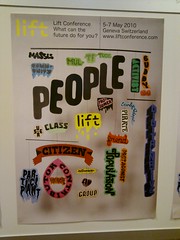 So, LIFT10 is over... time for a little retrospective.
So, LIFT10 is over... time for a little retrospective.
I brought a big sack of trepidation with me; the last two LIFTs I came to were so excellent that I was fully prepared to have my expectations confounded. Fortunately Laurent, Nicholas and their incredibly efficient team poured battery acid into the face of my pessimism by delivering what I thought was another excellent event.
It wasn't all roses - the Accenture talk on the last day was exactly the opposite of what I expect from LIFT, a quite salesy jargon-laden talk showing off ideas which I thought became pass&ecaute; when we slipped into a new millenium. The Old New Media session was also a little disappointing - I thought it'd be the high point for me, but I felt Catherine and Virginia concentrated too much time on showing us video clips and not enough on the really promising insights they started out with, and I lost focus during Mercedes' talk. To be fair to the latter, I have my suspicions that a career spent absorbing new ideas through bulletpoints may have degraded my ability to take in a more sophisticated presentation, and I'm looking forward to reading Mrs Bunz' talk in full.
But don't let a couple of quibbles fool you - LIFT maintained its well-above-average hit rate of interesting talks per day. Particular highlights (for me) included:
- Bjorn Jeffrey showing off Mag+; I'd oohed and aahed over the video a few times before, but hearing his tantalising explanation of 4 out of their 10 design principles was nonetheless fantastic, and I had the pleasure of hunting him down later for a more in-depth chat;
- Christian Heller asking us to rethink the "privacy = freedom" equation we all take for granted;
- Rahaf Harfoush of the World Economic Forum talking about the Obama campaign, its use of social media, and what that means post-campaign;
- Aubrey de Grey on regenerative medicine;
- Basile Zimmermann on tecnological and cultural differences between China and the West;
- Jamais Cascio on everyday approaches to futurism;
And those were the ones that were *excellent* - there were plenty of others which I found "merely" great. On top of this, it was pleasing to see good representation from the Brit contingent (in the form of Alice and Russell) and a way better-than-normal male/female balance of speakers.
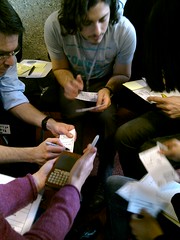 I also enjoyed the workshops. On day 1 I re-ran Mobile Mountains for a group of 15-20, which seemed to go down well (though I really do need to start varying the format a bit more to keep it fresh for myself), and on day 3 I went to Fred Destin's very participative workshop on Hacking Venture Capital... where we had the opportunity to spend 5 minutes preparing a pitch for a fictional company to a real VC, then turn the tables and play investors ourselves in a really fun negotiation game. Great stuff.
I also enjoyed the workshops. On day 1 I re-ran Mobile Mountains for a group of 15-20, which seemed to go down well (though I really do need to start varying the format a bit more to keep it fresh for myself), and on day 3 I went to Fred Destin's very participative workshop on Hacking Venture Capital... where we had the opportunity to spend 5 minutes preparing a pitch for a fictional company to a real VC, then turn the tables and play investors ourselves in a really fun negotiation game. Great stuff.
And this year even more than before, I found the conversations outside the talks really great: the Swiss democratic system, what the publishing industry does next, how Wikipedia was built on porn, the pleasure of poring through Silicon Valley emails published in court cases, were all fascinating lunchtime and evening topics.
Oh, and then there was the art. And the startups.
And the frogThink workshop where we looked at ways to improve the conference experience, and I mind-thieved a simple but beautifully effective brainstorming format.
And the wi-fi worked. All the time.
So kudos once more to the LIFT-folk for another great year, and roll on 2011!
LIFT10: Stories
May 07, 2010 | Comments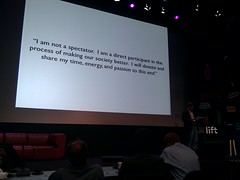 Yeon-ho Oh, OhMyNews: the story and future of citizen journalism
Yeon-ho Oh, OhMyNews: the story and future of citizen journalism
OhMyNews is direct democracy in media; every citizen is a reporter. Our ideas are not just commonplace, they're common sense. All online newspapers have users participating in many ways.
Shows an example of a Korean citizen journalist covering Chelsea football instead of sleeping. Many users have written >1000 stories. The passion of their reporters far exceed those of other staff at other newspapers.
Is citizen participation always good? When it's done for the right reasons. Sometimes citizens need someone to facilitate their passion. We also have staff reporters, who work with the citizen journalists. There were 4 staff when we started (including me)
...
 Basile Zimmermann, University of Geneva: Technology and Cultural Difference in China
Basile Zimmermann, University of Geneva: Technology and Cultural Difference in China
What's a cultural difference? Language and alphabets: web sites and email addresses are usually written in English. Why do character sets get corrupted or fail to display when you move between languages? Because English-speaking users were the first target for producers of computer systems - ASCII anyone?
How to enter Chinese text: type it phonetically, then choose from homophones. But after a while, people forget how to write by hand: knowledge of strokes isn't required by the system.
Shows the Google logo evolve over time. Compares to Baidu. Google has 30% market-share, Baidu 60%. Shows a Yahoo page with a version of the Baidu logo created with the reverse Chinese/English emphasis on the parts of the logo. IT LOOKS WRONG.
If you want to work with China, take a look at the Wikipedia page about unequal treaties with them. Every Chinese person knows about these, few people in the West know.
...
China will soon be one of the top 3 nations economically. The shift will reverse: China first. How will technology look on the day it was reinvented by the Chinese to fit their own needs?
- China is reinventing operating systems, DNS, and input mechanisms to suit their language.
- Computer technology embodies "western logic". Computers are great at chess, but bad at Go: the logic for these games is different. Perhaps the internal logic of the computer is something essentially Western, and Go just doesn't fit into it?
- China is the #1 country for the internet in terms of users and pages. The Chinese government thinks it'll help the economy, but they want to find out what is dangerous and what is not.
It's time to learn Chinese.
Chinese Internet users have a different way of reading web pages, the aesthetic is different. They tend to go online to have fun, where our bias is more for work. We use email a lot and IM less; in China the balance is reversed. Chinese users don't care much about censorship; while we in the West believe China is a dictatorship, it's not like that. Everything relating to religion, politics and pornography is monitored closely; but censorship isn't unique to China. The government there wants to keep things under control and avoid bad things happening, but that doesn't mean they want to control everything: think of the parent/child relationship as a model.
 Jamais Cascio, Institute For The Future: Wired for Anticipation.
Jamais Cascio, Institute For The Future: Wired for Anticipation.
Future as process, not destination.
Normally we're thinking about the end of the world; but the future isn't just a threat, it's adaptation and resilience. Shows a seed vault in Norway: a bank of seeds, "just in case" of global disaster.
Civilisation was born in the fires of catastrophe. Last great supervolcano drove us down to about 5000 hominids. After this time you see superior tools; grammar emerged; and ballistics (throwing things at a target), which uses the same neural mechanisms as prediction.
We tend to hang onto the future visions that we come up with. Think of foresight as a means of testing strategy, and you need a number of possible endpoints to think about. Most big businesses do scenario planning.
Shows Thorazine poster. What are the things we talk about now, that in a decade or three will look ridiculous? Grey goo nanotech? We're making a new future, but it's not one we want. It's not a supervolcano but could make many of us deeply unhappy. Futurists are trying to build a world where we're sensitive to different outcomes, so we can make a future we want.
The carbon footprint of cheeseburgers eaten in the US in a year equals the footprint of SUVs in the US for a year.
Futurists (by which I mean all of us) are the immune system for civilisation: seeing the potential of change early enough to take action.
Shows photo of Saturn eclipsing the sun - only visible from the far side of Saturn.
Channels Sagan.
All our tools, our manifestations of our ethics and culture... we act on the basis of how we understand the world. As we become more as gods, the imopact of our choices become more consequential. Technology is culture.
Alexandra Deschamps-Sonsino, tinker london: A Day in the Life of the tech-nerd-shop that brought us the Arduino
In year 3 of the business. Mainly employ jack-of-all-trades. Developed a platform called Arduino. Stopped doing it to let others carry on. Do lots of education, to get people to know them through tech they use.
Office in Silicon Roundabout. Work on building knowledge internally. Allow for idle time, but don't work it in.. it becomes work. They just allow people to do stuff, which eventually becomes something they talk about at conferences.
Open source everything.
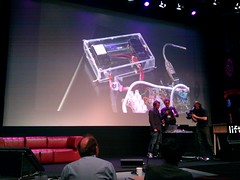 Fabian Hemmert, Deutsche Telekom Laboratories: Making Computers Stiff, Scratchy and Stubborn
Fabian Hemmert, Deutsche Telekom Laboratories: Making Computers Stiff, Scratchy and Stubborn
Works lot with mobiles. Ideal phone is light, thin, smart, slick, easy to use.
Think about alternatives: this is dull. Very interested in resistance: bounces light around, indicates physical tension. Make computers stiff, scratchy and stubborn. e.g. button with force-feedback that changes its resistance according to what you do with it - press hard to delete a contact, press light to take a photo.
Touch-screen which has a pen with break, to stop you moving it.
Breathing mobile phone. If you miss a call it gets excited and breathes faster, you need to calm it down by patting it.
Shape-changing mobile: an ebook that tells you how many pages are left to read by getting fatter/thinner.
LIFT10: Hacking Venture Capital, Fred Destin
May 07, 2010 | Comments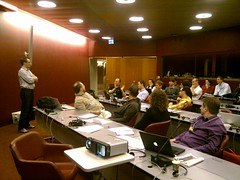 Hacking Venture Capital, Fred Destin
Hacking Venture Capital, Fred Destin
Part 1: pitching. Part 2: negotiation
Fred is a VC focused on early-stage funding for consumer-facing innovation: e-commerce, digital media. Moving back to the US, he's the only guy left in Europe.
We split into groups of 4 and work out how to pitch a fake company; a few groups pitch; we get harsh feedback.
Our group got up and pitched a fake version of Seedcamp winner ERPLY. Feedback on our pitch:
- Introduction was boring; everyone knows the small business market is huge. Liven it up with a personal anecdote, perhaps. I did this bit, and completely failed to use a great line one of the guys in our group came up with: "We're SAP for small businesses";
- We pitched our use of Amazon as a competitive advantage; this didn't add anything and wasted time;
- We didn't have a clear conclusion;
- Asking for investment in exchange for a stated 30% investment was poor practice;
A pitch is all about honing the story. To get good terms, you need multiple offers; to get multiple offers you need to tell a good story to several investors at the same time. Investors buy stories not businesses: they fall in love, then post-rationalise. You should be able to summarise your company on the back of a business card.
A decent elevator pitch is also a good tool for sharing a vision internally: it's a recruitment tool.
You don't need a business plan, executive summary or NDA. I've never heard of an NDA being enforced.
You need introductions (through an investor/entrepreneur); a high-concept pitch (3 words: "flickr of video"); a bottom-up, assumptions-driven model with any real numbers you can get in there. A model that an investor can play with and stress-test. An operating plan for next 12 months. Very clear milestones and deliverables. An explicit technical roadmap (not engineering documents, an outline). 10, 15, 5 KPIs by which success is measured (read Dave McClure, etc.). A cap table. Possibly credible market sizing.
Presentation doesn't matter; real-world traction is the most important thing. You're selling yourself: use social proof, if you don't have money you can find it in the ecosystem.
Elegance of product is important.
Tell a story; release your inner actor; smile; be true to yourself; raise pulse levels. Practice, practice, practice.
Let the audience have "aha" moments, so they feel they're smart and discovering things about your business. You're not allowed to have doubts about the team though.
In Europe, we have a tendency to be so fucking humble... err on the side of being salesy.
Embrace "pitch decay" - initial excitement decays over time. This is why you need to leave people with key takeaways. The VC you persuade will be your champion, and is now your sponsor - help him, make his life easy.
Be Israeli: doors close, come in through the window. 3-5 days after a meeting, follow up. No answer? Wait 2 days, follow up. VCs are busy and forget things, don't take it personally. Be pleasant enough that a VC could happily spent 8 hours stuck with you at an airport.
Part 2: negotiation
We split into teams of two: one team is investors, another entrepreneurs. They get different information on the company and their needs and negotiate. This was fun :)
Real-world valuations: they want to own 20-25% of any investment. So what's a reasonable price?
The only thing that really matters is price per share: bring it back to this every time. Option pools are important to build strong teams and legitimate but affect this.
Don't let investors tell you the size of the option pool (though they can provide useful input). Use a hiring plan to justify a small option pool, increase your share price and increase your effective valuation. Underestimating the size of the option pool is a classic mistake.
Liquidation preferences are designed to push the valuation hurdle out and ensure investors get their money back.
Boards are important. Companies are benevolent dictatorships; the board exists to ensure he's optimally benevolent. The CEO works for the board. Bad dictators get beheaded...
Legals are designed to cover a downside - you get run over by a bus and investors end up dealing with your heir. Don't take them personally. Secure the social contract: companies always go wrong at some point, and big companies have big problems. Documents don't help here, but a social contract will.